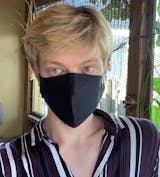You order an expensive new cream online, and are excited when your order arrives. It’s in a medium-size box with gorgeous lettering, and you open the box to reveal folds and folds of beautiful paper, and a neat cardboard insert with your cream gently nestled in it. You love the packaging, and have a great first impression of the product.
However, what happens ten minutes later? Do you reuse, repurpose or recycle the packaging? Or does it all go into the bin?
Excessive packaging is a simple tactic employed by high-end brands to increase anticipation and to make their product appear more luxurious. It’s a clever trick that works, but its environmental impact is awful. That is why we want to discuss excessive packaging, how to deal with it, and how to try and avoid it.
Fait avec Coeur is a sustainable beauty company that partners with brands that sell eco-friendly products with minimalist packaging. Our own products come with packaging that’s as sustainable as possible.
Why Excessive Packaging is Harmful
Excessive or luxury packaging is any packaging that isn’t necessary to contain or protect the product. The cardboard box that your product comes in is necessary for shipping, and it likely comes with bubble wrap or packing peanuts to keep the contents safe. Next, there’s the actual product itself – the plastic, glass or metal container it comes in for storage and use. All of this is necessary, although there’s no reason why it can’t be recycled or reused. However, anything additional is considered unnecessary in most cases.
Now let’s come to the problem. We throw out a lot of packaging – it makes up nearly half the waste worldwide. While some of us are conscientious and try and recycle as much as we can, there exist litter louts – people who lack the motivation to dispose of their waste properly, and just discard it wherever seems convenient.
The luxury products market is booming, and with that comes an increase in luxury packaging, and waste material. In America, the average individual creates nearly five pounds of waste every day! A lot of this waste makes its way out to the sea and forms not-so-delightful little islands, like the Great Pacific Garbage Patch, which is a great mass of floating plastic twice the size of Texas.
The Worst Offenders
It’s obvious that the big-name brands that churn out the most products annually will be at the top of the list, but which ones are they? And what industries contribute the most to this problem?
According to Greenpeace, here are the top 10 brands that contribute the most to plastic pollution worldwide:
- Coca-Cola
- PepsiCo
- Nestlé
- Danone
- Mondelez International
- Procter & Gamble
- Unilever
- Perfetti van Melle
- Mars Incorporated
- Colgate-Palmolive
P&G owns brands such as Pantene, Herbal Essences, Olay, My Black Is Beautiful, Head & Shoulders, and Old Spice. Unilever is the owner of Axe, Dove, Vaseline, TRESemme, Nexxus, Pond’s and Q-Tips. If you use products from these brands, switch to sustainable beauty products today! Try and avoid purchasing food items that come wrapped in plastic. Be a part of the solution, not the problem.
How to Dispose of Your Waste Properly
If you want to help the environment but think it’s too much work or too time-consuming, remember this – you need to make time to improve the world around you, just like you’d make time for yourself. If you spend an extra ten minutes every day dealing with your recyclables, you will develop a healthy habit that will slowly help create a better world. Here’s how to help:
Cardboard
Most places offer curb-side recycling for cardboard boxes, and you can also compost them if you have a garden. To recycle, remove any liners, packing peanuts and tape. Cut out any stains that may make the boxes un-recyclable, and flatten the boxes before putting them in the bin.
Paper
Paper inserts, tissue and padding make up a good chunk of excessive packaging. Make sure you put all of this into the recycling bin. However, bear in mind that tissue paper usually can’t be recycled, so if you need some lightweight weed suppressant in the garden, that may be a better way to reuse some of your trash.
If the paper is stained with beauty product, it is not fit for recycling, so that goes into the trash.
Plastic
Recycling plastic is complex because there are a lot of different types of plastic, and not all of them are recyclable. Check your county’s website for a full list of items they recycle. Generally, most places accept shampoo and lotion bottles, cream jars, and such. The general rule is that anything that can be squeezed (think tubes of toothpaste or face wash) can’t be recycled, whereas hard plastic can. Caps and lids, cling film and sheet plastic also can’t be recycled.
Some supermarkets and councils recycle plastic bags, plastic film and bubble wrap. You can also reuse bubble wrap if you can’t find a place near you that recycles them. If in doubt, look up “X recycling near me”, and Google will help you out.
We hope that helps you with how to dispose of any excessive packaging you might receive in a responsible manner. Don’t be a litter lout. Being eco-friendly requires a little effort, but the peace of mind and reduced ecological footprint are more than worth it. We aren’t asking you to go out of your way to get every tiny scrap of plastic recycled; just be efficient and regular.
Five Sustainable Beauty Brands We Love For Their Packaging
There are many companies out there that genuinely care about our Earth, that are trying to improve their packaging (and products) so they’re more sustainable. Here are five beauty brands that we love for their eco-friendly packaging:
Their packaging is plastic-free, and all the materials used in marketing and shipping are considered recyclable and/or compostable. Their veggie-coated paper is printed using plant-based inks that are nontoxic, and therefore safe to compost. They calculate their orders through a carbon offset calculator to make sure they’re carbon neutral.
They are an Earth-friendly company with products that come in recyclable containers, with recyclable lids - which is so great, because brands often focus on the container and forget all about the lid. They use shrink wrap only when absolutely necessary, and are on the lookout for more eco-friendly options.
Their packaging is waste-free, with recyclable and reusable materials. Their products come in glass containers, and they use recycled ocean-bound plastic, ocean-waste plastic, or PCR plastic when they can. They get their packaging materials from local suppliers to keep their carbon footprint minimal. They also use no unnecessary plastic, so you know they’re a brand that’s not about excessive packaging!
They offer a truly zero-waste eyeshadow palette, with soy-based inks, aluminium eyeshadow pans, and a recycled palette, box and tarot card. Their products (and packaging) are fully recyclable – while still being stunning! We recommend the ATHR Beauty Joshua tree Palette for a fabulous product with double-fab packaging.
This Hawaiian brand promises sustainable products, and they deliver on their promise with products that contain Earth-friendly ingredients, and come in glass bottles or recyclable jars. The outer cartons used are made with kraft paper, which can be recycled as well. They get their ingredients from farmers who avoid using pesticides or harsh chemicals.
It’s a good idea to cut down on void fill and other excessive packaging, but when it’s unavoidable, you can always go with greener options – whether it’s recycled paper, twine, shredded paper, green-wrap, or eco-friendly alternatives to bubble wrap!
Fait avec Coeur is All About Sustainable Packaging
We provide sustainable beauty products that don’t have a negative impact on the environment, and our packaging is eco-friendly too. We try and avoid plastic as much as we can. Our Hyaluronic Acid Serum, for instance, comes in a recyclable glass bottle, which is encased in a minimalistic cylindrical container for safety.
Our Organic Bamboo Viscose Sheet Set comes in a fabric bag, and the parcel is shipped in an EcoEnclose envelope. These are recycled (and recyclable, and biodegradable) paper envelopes that are sturdy and attractive, while having a tiny environmental footprint.
Our products are extremely gentle – both on your skin and on the environment. The bamboo sheets are made with pure bamboo viscose, and are therefore moisture-wicking and thermal regulating while being extremely luxurious. The best part yet is that you can have these luxurious bedsheets for a very affordable amount. Not only is bamboo great for the environment, but it’s also a very affordable material.
We are constantly on the lookout for ways to improve, whether that’s by partnering with green brands, producing environmentally-friendly products, switching to greener packaging, or by adopting policies that change the world for the better. We strongly believe that luxury and sustainability can go hand in hand – you just have to extend some effort.










